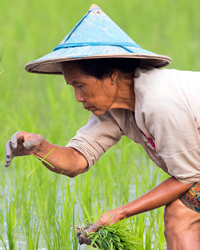Karen, Tharmitaik in Myanmar (Burma)

Photo Source:
Asia Harvest-Operation Myanmar
|
Send Joshua Project a map of this people group.
|
| People Name: | Karen, Tharmitaik |
| Country: | Myanmar (Burma) |
| 10/40 Window: | Yes |
| Population: | 2,300 |
| World Population: | 2,300 |
| Primary Language: | Language unknown |
| Primary Religion: | Buddhism |
| Christian Adherents: | 8.00 % |
| Evangelicals: | 3.00 % |
| Scripture: | Unspecified |
| Ministry Resources: | No |
| Jesus Film: | No |
| Audio Recordings: | No |
| People Cluster: | Karen |
| Affinity Bloc: | Tibetan-Himalayan Peoples |
| Progress Level: |
|
Identity
The Tharmitaik Karen people are a newly-discovered group and are called Karenbyu (“White Karen”) by neighboring ethnicities. The people themselves are not sure what the name Tharmitaik means. Various theories as to how the name “White Karen” initially came to be given them were offered by their leaders. One said, “It signifies pure (innocent) Karen, having no sin. Others told a legend that a woman was once born with white skin and was hidden to avoid being claimed by the king. Albino people continue to be born into each generation, and we found four albino Tharmitaik people in the village of Mandat Taung. Other village names include Ban Pha, Koe Dit, and Padaung Koe.”
Location: With a population of just 2,300 people, the Tharmitaik Karen, who inhabit 455 households in nine villages, are the second smallest of more than 20 Karen tribes profiled in this book, with only the Htee Day Karen having a smaller population, numbering 2,000. Tharmitaik Karen territory is in eastern Myanmar's Kayin State. All nine communities sit within the Thandaunggyi Township of Hpa-An District. Hpa-An is famous for its many extraordinary limestone rock formations. The area would undoubtedly be a place of great interest for foreign tourists, but few are bold enough to travel to this troubled part of Myanmar that has been wracked by decades of armed conflict. Thandaunggyi is a historically important place for Karen people from many groups, with special Karen New Year's celebrations held on a mountaintop there.
Language: When linguists visited this group several years ago, they determined that the Tharmitaik language is distinct from other Karen varieties in Myanmar, although one source suggests it may be a dialect of the larger Geba Karen group. Tharmitaik is probably part of the Northern Karenic group of the Tibeto-Burman linguistic family, a group that includes the Lahta, Yinbaw, Yintale, and Zayein languages.
History
Although they are believed to have lived in Myanmar for centuries, nothing is known of the origins of the Tharmitaik Karen. A 1922 National Geographic article noted: “There are a great many Karens who are commonly referred to by their Burmese neighbors and strangers as ‘White Karens.' These Karens do not admit the hill Karens to be their relations and have the same feelings regarding them that Abel had for Cain.... The most baffling thing is that the Karens have no national comprehensive name for themselves, not even for the most numerous and enlightened branch...and what legends they have only lead the learned to disagree, more or less acrimoniously, with one another."
Customs
Many of the Karen tribes in Myanmar famously embraced Christianity because the message closely mirrored their ancient stories of creation. A 19th century missionary wrote: “One of the most interesting races in the world are the Karens of Burma. Tucked away in an obscure corner of the earth, they were nevertheless marvellously kept of God through many generations for the reception of the Gospel…. These people were hidden away from the observation of men to be brought forth within recent times.”
Religion
Alas, despite the rich spiritual heritage of other Karen groups who embraced the Bible because they saw it as their lost book, the Tharmitaik had already become entrenched in the Buddhist faith by the time missionaries first arrived in their area. Almost all Tharmitaik Karen people remain Buddhists today apart from a small number of Christians who are found in one or two villages.
Christianity
The Tharmitaik Karen living in Mandat Taung village have a small number of Catholic and Anglican believers in their midst. No Scripture or any other form of Christian media has ever been produced to aid those interested in the evangelization of this fascinating group, who until now have never appeared in any mission lists of the world's people groups.